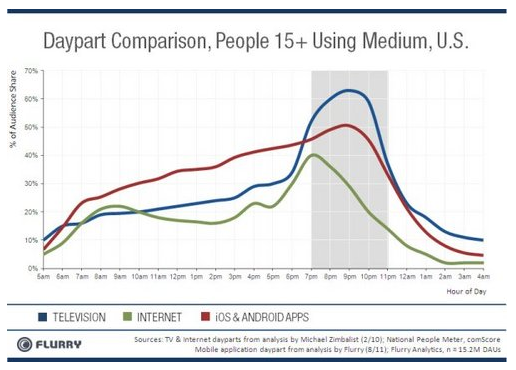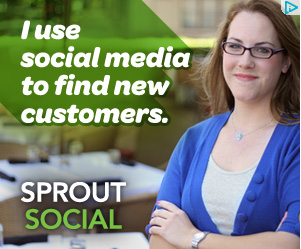Prime Time in TV and Mobile Apps is similar
The prime time for TV broadcasters is 7 p.m. to 11 p.m., for radio it is all about commute time, and for the web it is completely different. While news sites have their peak in the morning and midday, the internet at 7 pm. Social Media sites have their main usage time in the evening like TV. And how about mobile web usage? Is it following TV’s prime time?
A study by Flurry shows the audience for iPhone and iOS apps increases during the day and finds it’s peak at about 9 p.m. “Mobile consumers are using apps either instead of, or along-side prime-time television and the Internet,” tells us a Flurry blog post on the study. Well, it is a US usage study but I can imagine that many people in the rest of the world also change their habits and use mobile devices while watching TV. The two-screen viewing seems to become common standard.
Nevertheless, the relative size of the TV audience during prime time was larger than that for mobile apps with over 60%. And when app usage remained higher than TV from 6 a.m. to 6 p.m., and higher than the Internet, it suggests that people spend quite some time accessing the Web during their working hours. Still, mobile apps already reach over 20 million U.S. consumers per hour in the time between 7 a.m. to 11 p.m.

The numbers come as no surprise, seeing that Flurry estimates the combined number of active iOS and Android devices in the U.S. at 110 million. If produced properly and promoted correct, apps could act like TV shows in the future. Although it will be difficult to target apps through app stores by age, gender, dayparts like TV, the future could look different and these targeting opportunities might evolve over time.
Spot On!
The question is what the future of app usage will look like (think about HTML 5 and some other reasons) and how this will affect the advertising industry. At the moment, many companies focus their main interest on apps but mainly to push their brands, and not often to create something extraordinary that really competes with TV. Although, there s a massive opportunity to reach mobile consumers overtime, everywhere, companies are not very innovative in establishing TV like series that could affect the TV world – neither in Social Media, nor in Mobile. If this remains as it is, TV will not have to fear the Prime Time power of mobile.

 Is this a good sign for the acceptance of social media in the business world? The use of Twitter as a business and marketing tool has increased from 31% to 61% among Europe’s top business leaders, finds a recent study by CNBC.
Is this a good sign for the acceptance of social media in the business world? The use of Twitter as a business and marketing tool has increased from 31% to 61% among Europe’s top business leaders, finds a recent study by CNBC.




 What will companies say if employees want to bring their own devices to work? How about security issues and support opportunities for companies? A real challenge for the future when we look at an
What will companies say if employees want to bring their own devices to work? How about security issues and support opportunities for companies? A real challenge for the future when we look at an 